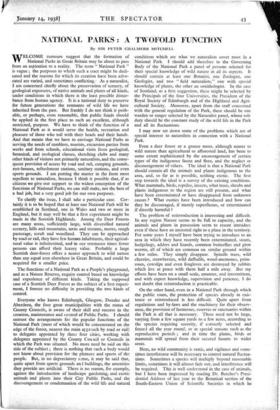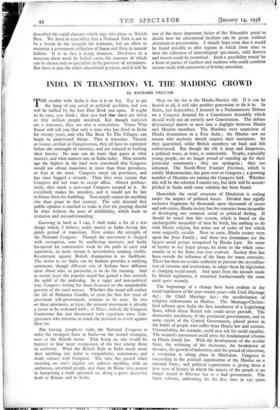NATIONAL PARKS : A TWOFOLD FUNCTION
By SIR PETER CHALMERS MITCHELL
WELCOME rumours suggest that the formation of National Parks in Great Britain may be about to pass from an aspiration to a reality. The term " National Park " is vague ; the purposes to which such a tract might be dedi- cated and the reasons for which its creation have been advo- cated are varied, and sometimes conflicting.- -As a naturalist, I am concerned chiefly about the preservation of scenery, of geological exposures, of native animals and plants of all kinds, under conditions in which there is the least possible distur- bance from human agency. It is a national duty to preserve for future generations the remnants of wild life we have inherited from the past. But frankly I do not think it prob- able, or perhaps, even reasonable, that public funds should be applied in the first place to such an excellent, although restricted, purpose. We have to think of the function of a National Park as it would serve the health, recreation and pleasure of those who toil with their heads and their hands. And that means that we have to envisage National Parks as Serving the needs of ramblers, tourists, excursion parties from works and from schools, educational visits from geological, botanical, and zoological classes, sketching clubs and many other kinds of visitors not primarily naturalists, and the conse- quent provision of access by road and rail, camping grounds, rest-houses, refreshment stations, sanitary stations, and even sports grounds. I am putting the matter in the form most repellent to naturalists, because I think it possible that, if as citizens we give our support to the widest conception of the functions of National Parks, we can still make, not the best of a bad job, but a very good job for our own purposes.
To clarify the issue, I shall take a particular case. Cer- tainly it is to be hoped that at least one National Park will be established in Scotland, one in Wales and two or more in England, but it may well be that a first experiment might be made in the Scottish Highlands. Among the Deer Forests are many areas, sufficiently large, with diversified natural scenery, hills and mountains, tarns and streams, moors, rough pasturage, scrub and woodland. They can be approached by road or rail, they have few hum= inhabitants, their agricul- tural value is infinitesimal, and.in our strenuous times fewer persons can afford their luxury value. Probably a large Scottish deer-forest offers a nearer approach to wild nature than any equal area elsewhere in Great Britain, and could be acquired for a smaller price.
The functions of a National Park as a People's playground, and as a Nature Reserve, require control based on knowledge and experience of different kinds. Taking the supposed case of a Scottish Deer Forest as the subject of a first experi- ment, I foresee no difficulty in providing the two kinds of control.
Everyone who knows Edinburgh, Glasgow, Dundee and Aberdeen, the four great municipalities with the status of County Councils, is aware of their skill and success in the creation, maintenance and control of Public Parks. I should entrust the arrangements for the popular functions of the National Park (most of which would be concentrated on the edge of the forest, nearest the main arpraach by road or rail) to delegates appointed by these four cities, working with delegates appointed by the County Couacil or Councils in which the Park was situated. No more need be said on this side of the subject ; there is nothing that such a body would not know about provision for the pleasure and sports of the people. But, in no depreciatory sense, it may be said that, quite apart from sports grounds and buildings, the amenities they provide are artificial. There is no reason, for example, against the introduction of landscape gardening, and exotic animals and plants into their City Public Parks, and the discouragement or condemnation of the wild life and natural conditions which are what we naturalists covet most in a National Park. I should add therefore to the Governing Body of the National Park a panel of persons selected for their special knowledge of wild nature in all its aspects. It should contain at least one Botanist, one Zoologist, one Geologist, and two " field naturalists," one with special knowledge of plants, the other an ornithologist. In the case of Scotland, as a first suggestion, these might be selected by the Principals of the four Universities, the President of the Royal Society of Edinburgh and of the Highland and Agri- cultural Society. Moreover, apart from the staff concerned with the general regulation of the Park, there should be one warden or ranger selected' by the Naturalist panel, whose sole duty should be the constant study of the wild life in the Park and all its fluctuations.
I may now set down some of the problems which are of special interest to naturalists in connexion with a National Park.
Even a deer forest or a grouse moor, although nearer to wild nature than agricultural or afforested land, has been to some extent sophisticated by the encouragement of certain types of the indigenous fauna and flora, and the neglect or discouragement of others. The ideal is that a National Park should contain all the animals and plants indigenous to the area, and, so far as is possible, nothing exotic. The first step towards the ideal is a survey of the existing conditions. What mammals, birds, reptiles, insects, what trees, shrubs and plants indigenous to the region are still present, and what have been exterminated or have disappeared from unknown causes ? What exotics have been introduced and how can they be discouraged, if merely superfluous, or exterminated if directly harmful ?
The problem of reintroduction is interesting and difficult. In any region Nature seems to be full to capacity, and the animals and plants in possession seem to resent intruders even if these have an ancestral right to a place in the territory. For some years I myself have been trying to introduce to an area in which they have recently been exterminated, stoats, hedgehogs, adders and lizards, common butterflies and glow worms, all of which are common on similar ground within a few miles. They simply disappear. Spindle trees, wild cherries, strawberries, wild daffodils, wood-anemones, prim- roses, cowslips and even foxgloves are destroyed by rabbits which live at peace with them half a mile away. But my efforts have been on a small scale, amateur, and intermittent, and with expert knowledge, supervision and patience, I do not doubt that reintroduction is practicable.
On the other hand, even in a National Park through which the public roam, the protection of species already in exis- tence or reintroduced is less difficult. Quite apart from regulations and by-laws and the machinery for their observ- ance, the provision of fastnesses, reserves or sanctuaries within the Park is all that is necessary. These need not be large, varying from a few square yards to a few acres, according to the species requiring security, if correctly selected and fenced all the year round, or at special seasons such as the reproductive periods ; and in time the plants, birds or mammals will spread from their secured haunts to wider areas.
Next, no wild community is static, and vigilance and some- times interference will be necessary to control natural fluctua- tions. Sometimes a species will multiply beyond reasonable limits, sometimes it will almost fade out, and interference will be required. This is well understood in the case of animals, but I have been impressed by reading Dr. Butcher's Presi- dential Address of last year to the Botanical section of the South-Eastern Union of Scientific Societies in which he described the rapid changes which may take place in British flora. We have to remember that a National Park is not to be a lesson in the struggle for existence, but an effort to maintain a permanent collection of fauna and flora in natural habitat. It is in fact a living museum. Doubtless in a museum there must be locked cases, the contents of which can be shown only to specialists in the presence of attendants. But there is also the wider educational purpose, and it will be One of the more important duties of the Naturalist panel to decide how far educational facilities can be given without detriment to preservation. I should hope even that it would be found possible to allot regions in which from time to time the collection of mineralogical specimens, wild flowers and insects could be permitted. Such a possibility would be a boon to parties of teachers and students who could combine serious study with enjoyment of holiday amenities.







































 Previous page
Previous page